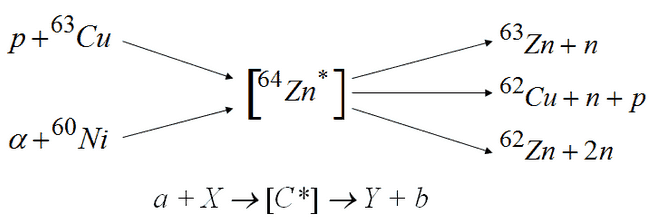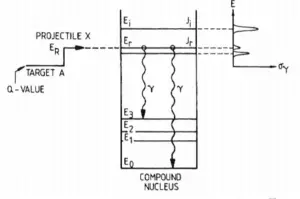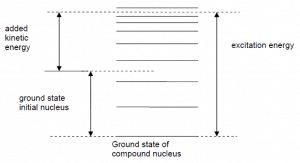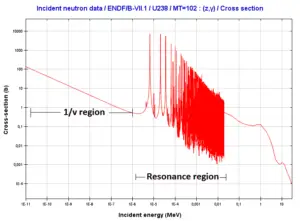Nuclear Reactions – Basic Classification
A nuclear reaction is considered to be the process in which two nuclear particles (two nuclei or a nucleus and a nucleon) interact to produce two or more nuclear particles or ˠ-rays (gamma rays). Thus, a nuclear reaction must cause a transformation of at least one nuclide to another. Sometimes if a nucleus interacts with another nucleus or particle without changing the nature of any nuclide, the process is referred to a nuclear scattering, rather than a nuclear reaction.
In order to understand the nature of nuclear reactions, the classification according to the time scale of of these reactions has to be introduced. Interaction time is critical for defining the reaction mechanism.
There are two extreme scenarios for nuclear reactions (not only neutron nuclear reactions):
- A projectile and a target nucleus are within the range of nuclear forces for the very short time allowing for an interaction of a single nucleon only. These type of reactions are called the direct nuclear reactions.
- A projectile and a target nucleus are within the range of nuclear forces for the time allowing for a large number of interactions between nucleons. These type of reactions are called the compound nucleus reactions.
In fact, there is always some non-direct (multiple internuclear interaction) component in all reactions, but the direct reactions have this component limited.
Compound Nucleus Reactions
This compound system is a relatively long-lived intermediate state of particle-target composite system and from the definition, the compound nucleus must live for at least several times longer than is the time of transit of an incident particle across the nucleus (~10-22 s). The time scale of compound nucleus reactions is of the order of 10-18 s – 10-16 s, but lifetimes as long as 10-14 s have been also observed.
Very important feature and a direct consequence of the thermal equilibrium inside a compound nucleus is the fact the mode of decay of compound nucleus does not depend on the way the compound nucleus is formed. The large number of collisions between nucleons leads to the loss of the information on the entrance channel from the system. The decay mechanism (exit channel) that dominates the decay of C* is determined by the excitation energy in C* and by the law of probability.
These reactions can be considered as a two-stage processes.
- The first stage is the formation of a compound nucleus expressed by σa+X➝C*
- The second stage is the decay of a compound nucleus expressed by PC*➝b+Y
- The result cross-section of certain reaction a+X➝[C*]➝b+Y is given by σ(a,b)= σa+X➝C* . PC*➝b+Y

Resonances
Resonances (particular compound states) are mostly created in neutron nuclear reactions, but it is by no means restricted to neutron nuclear reactions. The formation of resonances is caused by the quantum nature of nuclear forces. Each nuclear reaction is a transition between different quantum discrete states or energy levels. The discrete nature of energy transitions plays a key role. If the energy of the projectile (the sum of the Q value and the kinetic energy of the projectile) and the energy of target nucleus is equal to a compound nucleus at one of the excitation states, a resonance can be created and peak occurs in the cross section. For light nucleus, the allowable state density in this energy region is much lower and the “distance” between states is higher. For heavy nuclei, such as 238U, we can observe large resonance region in the neutron absorption cross-section.
It is obvious the compound states (resonances) are observed at low excitation energies. This is due to the fact, the energy gap between the states is large. At high excitation energy, the gap between two compound states is very small and the widths of resonances may reach the order of the distances between resonances. Therefore at high energies no resonances can be observed and the cross section in this energy region is continuous and smooth.


 Region of resonances of 238U nuclei.
Region of resonances of 238U nuclei.Source: JANIS (Java-based Nuclear Data Information Software); The ENDF/B-VII.1 Nuclear Data Library
Direct Reactions vs. Compound Nucleus Reactions
Direct Reactions
- The direct reactions are fast and involve a single-nucleon interaction.
- The interaction time must be very short (~10-22 s).
- The direct reactions require incident particle energy larger than ∼ 5 MeV/Ap. (Ap is the atomic mass number of a projectile)
- Incident particles interact on the surface of a target nucleus rather than in the volume of a target nucleus.
- Products of the direct reactions are not distributed isotropically in angle, but they are forward focused.
- Direct reactions are of importance in measurements of nuclear structure.
Compound Nucleus Reactions
- The compound nucleus is a relatively long-lived intermediate state of particle-target composite system.
- The compound nucleus reactions involve many nucleon-nucleon interactions.
- The large number of collisions between the nucleons leads to a thermal equilibrium inside the compound nucleus.
- The time scale of compound nucleus reactions is of the order of 10-18 s – 10-16 s.
- The compound nucleus reactions is usually created if the projectile has low energy.
- Incident particles interact in the volume of a target nucleus.
- Products of the compound nucleus reactions are distributed near isotropically in angle (the nucleus loses memory of how it was created – the Bohr’s hypothesis of independence).
- The mode of decay of compound nucleus do not depend on the way the compound nucleus is formed.
- Resonances in the cross-section are typical for the compound nucleus reaction.
We hope, this article, Compound Nucleus Reaction, helps you. If so, give us a like in the sidebar. Main purpose of this website is to help the public to learn some interesting and important information about radiation and dosimeters.